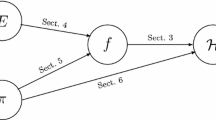Abstract
We investigate generic methods to find near-collisions in cryptographic hash functions. We introduce a new generic approach based on methods to find cycles in the space of codewords of a code with low covering radius. We give an analysis of our approach and demonstrate it on the SHA-3 candidate TIB3.
Similar content being viewed by others
References
Barg A., Forney G.D. Jr.: Random codes: minimum distances and error exponents. IEEE Trans. Inf. Theory 48(9), 2568–2573 (2002)
Brent R.P.: An improved Monte Carlo factorization algorithm. BIT 20(2), 176–184 (1980)
Canetti R., Rivest R.L., Sudan M., Trevisan L., Vadhan S.P., Wee H.: Amplifying collision resistance: a complexity-theoretic treatment. In: Menezes, A. (ed.) CRYPTO, Lecture Notes in Computer Science, vol. 4622, pp. 264–283. Springer, Heidelberg (2007)
Cohen G., Honkala I., Litsyn S., Lobstein A.: Covering codes, vol. 54 of North-Holland Mathematical Library. North-Holland Publishing Co., Amsterdam (1997)
Cohen H., Frey G., Avanzi R., Doche C., Lange T., Nguyen K., Vercauteren F. (eds.): Handbook of Elliptic and Hyperelliptic Curve Cryptography. Discrete Mathematics and its Applications (Boca Raton). Chapman & Hall/CRC, Boca Raton, FL (2006).
Damgård I.: A design principle for hash functions. In: Brassard, G. (ed.) CRYPTO, Lecture Notes in Computer Science, vol. 435, pp. 416–427. Springer, Heidelberg (1989)
den Boer B., Bosselaers A.: Collisions for the compression function of MD5. In: Goos, G., Hartmanis, J. (eds) EUROCRYPT, Lecture Notes in Computer Science, vol. 765, pp. 293–304. Springer, Heidelberg (1993)
Gordon D., Miller V., Ostapenko P.: Optimal hash functions for approximate matches on the n-cube. IEEE Trans. Inform. Theory 56(3), 984–991 (2010)
Graham R.L., Sloane N.J.A.: On the covering radius of codes. IEEE Trans. Inform. Theory 31(3), 385–401 (1985)
Harris B.: Probability distributions related to random mappings. Ann. Math. Stat. 31, 1045–1062 (1960)
Kéri G.: Tables for bounds on covering codes. http://www.sztaki.hu/~keri/codes/. Accessed 17 May 2010.
Knuth D.E.: The art of computer programming. Seminumerical algorithms, Addison-Wesley Series in Computer Science and Information Processing, vol. 2, third edn. Addison-Wesley Publishing Co., Reading, MA, (1997).
Matyas S.M., Meyer C.H., Oseas J.: Generating strong one-way functions with crypographic algorithm. IBM Tech. Discl. Bull. 27(10A), 5658–5659 (1985)
Mendel F., Schläffer M.: On free-start collisions and collisions for TIB3. In: Samarati P., Yung M., Martinelli F., Ardagna C.A. (ed) ISC, Lecture Notes in Computer Science, vol. 5735, pp. 95–106. Springer, Heidelberg (2009).
Menezes A., van Oorschot P.C., Vanstone S.A.: Handbook of Applied Cryptography. CRC Press, Boca Raton (1996)
Merkle R.C.: One way hash functions and DES. In: Brassard G. (ed.) CRYPTO, Lecture Notes in Computer Science, vol. 435, pp. 428–446. Springer, Heidelberg (1989).
Montes M., Penazzi D.: The TIB3 Hash. Submission to NIST (2008).
National Institute of Standards and Technology (NIST): FIPS-180-2: Secure Hash Standard. http://www.itl.nist.gov/fipspubs/ (2002).
National Institute of Standards and Technology (NIST): Cryptographic Hash Project. http://www.nist.gov/hash-competition (2007).
Nivasch G.: Cycle detection using a stack. Inf. Process. Lett. 90(3), 135–140 (2004)
Pless V.: Introduction to the theory of error-correcting codes. Wiley-Interscience Series in Discrete Mathematics and Optimization, third edn. Wiley, New York (1998)
Pollard J.M.: Monte Carlo methods for index computation (mod p). Math. Comp. 32(143), 918–924 (1978)
Quisquater J.-J., Delescaille J.-P.: How easy is collision search. new results and applications to DES. In: Brassard G. (ed.) CRYPTO Lecture Notes in Computer Science, vol. 435, pp. 408–413. Springer, Heidelberg (1989).
Rivest R.: RFC1321—The MD5 Message-Digest Algorithm (1992).
Struik R.: An improvement of the Van Wee bound for binary linear covering codes. IEEE Trans. Inform. Theory 40(4), 1280–1284 (1994)
van Oorschot P.C., Wiener M.J.: Improving implementable meet-in-the-middle attacks by orders of magnitude. In: Koblitz N. (ed.) CRYPTO, Lecture Notes in Computer Science, vol. 1109, pp. 229–236. Springer, Heidelberg (1996).
van Oorschot P.C., Wiener M.J.: Parallel collision search with cryptanalytic applications. J. Cryptol. 12(1), 1–28 (1999)
van Wee G.J.M.: Improved sphere bounds on the covering radius of codes. IEEE Trans. Inform. Theory 34(2), 237–245 (1988)
Wang X., Yu H.: How to break MD5 and other hash functions. In: Cramer, R. (ed.) EUROCRYPT, Lecture Notes in Computer Science, vol. 3494, pp. 19–35. Springer, Heidelberg (2005)
Wang X., Yin Y.L., Yu H.: Finding collisions in the full SHA-1. In: Shoup, V. (ed.) CRYPTO, Lecture Notes in Computer Science, vol. 3621, pp. 17–36. Springer, Heidelberg (2005)
Yuval G.: How to swindle Rabin?. Cryptologia 3(3), 187–191 (1979)
Author information
Authors and Affiliations
Corresponding author
Additional information
Communicated by S. D. Galbraith.
Rights and permissions
About this article
Cite this article
Lamberger, M., Mendel, F., Rijmen, V. et al. Memoryless near-collisions via coding theory. Des. Codes Cryptogr. 62, 1–18 (2012). https://doi.org/10.1007/s10623-011-9484-2
Received:
Revised:
Accepted:
Published:
Issue Date:
DOI: https://doi.org/10.1007/s10623-011-9484-2




